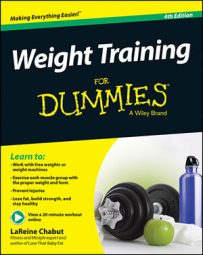Knowing how you stack up against others who’ve taken similar fitness tests can motivate you to work hard when weight training. Plus, it can serve as a great measure of how you’re progressing as you work out. Here are some tests you can do to measure your strength and endurance.
Keep track of your results in a workout log, and retest yourself ever month or so, to see how you’re doing.
You’ll have better results if you’re warm before you attempt these tests.
The term strength testing is somewhat of a misnomer. Strictly speaking, your strength refers to the maximum amount of weight that you can lift one time — also called your one-rep max. For example, if you squeeze out only one shoulder press with 45 pounds, that’s your one-rep max for that exercise.
In general, it’s not such a hot idea to go around testing your one-rep maxes, especially if you’re a beginner. Some veterans like to go all out sometimes, but they typically test their one-rep max for just one or two exercises in a given workout. Pushing to the max places a lot of stress on your body parts and can cause extreme muscle soreness even in experienced weight lifters.
Comparing your upper-body strength
A commonly administered test for upper-body strength is the push-up test. Men do military push-ups. Women do modified push-ups (with their knees on the ground). Do as many push-ups as you can until you can no longer do another one with good form.
The best way to take the test is with a friend, family member, or training partner who counts your reps out loud for you. Record the date and number for your records.
| Age 20–29 | Age 30–39 | Age 40–49 | Age 50–59 | Age 60+ | |
|---|---|---|---|---|---|
| Excellent | 55+ | 45+ | 40+ | 35+ | 30+ |
| Good | 45–54 | 35–44 | 30–39 | 25–34 | 20–29 |
| Average | 35–44 | 25–34 | 20–29 | 15–24 | 10–19 |
| Fair | 20–34 | 15–24 | 12–19 | 8–14 | 5–9 |
| Low | 0–19 | 0–14 | 0–11 | 0–7 | 0–4 |
| Age 20–29 | Age 30–39 | Age 40–49 | Age 50–59 | Age 60+ | |
|---|---|---|---|---|---|
| Excellent | 49+ | 40+ | 35+ | 30+ | 20+ |
| Good | 34–48 | 25–39 | 20–34 | 15–29 | 5–19 |
| Average | 17–33 | 12–24 | 8–19 | 6–14 | 3–4 |
| Fair | 6–16 | 4–11 | 3–7 | 2–5 | 1–2 |
| Low | 0–5 | 0–3 | 0–2 | 0–1 | 0 |
Comparing your abdominal strength
The crunch test is another commonly used assessment that is easy to do at home with a friend, family member, or training partner.
Lie on your back on your training mat with your knees bent and arms resting at your sides, palms facing down. Have your partner mark a horizontal line with masking tape on each side of your body at the end of your fingertips. Place a second piece of tape parallel to the first piece toward your feet – about 2-1/2 inches down the mat.
To begin the test, align your fingertips with the first marking. Crunch upward and slide your fingers along the mat to the second line. Lower completely to the starting position. Continue to do as many reps as you can. Move rhythmically in a smooth, controlled manner.
Avoid using momentum and lifting your body up and down rapidly. Record the date and number of reps for your records.
| Under Age 35 | Age 36–45 | Over Age 45 | |
|---|---|---|---|
| Excellent | 60 | 50 | 40 |
| Good | 45 | 40 | 25 |
| Marginal | 30 | 25 | 15 |
| Needs work | 15 | 10 | 5 |
| Under Age 35 | Age 36–45 | Over Age 45 | |
|---|---|---|---|
| Excellent | 50 | 40 | 30 |
| Good | 40 | 25 | 15 |
| Marginal | 25 | 15 | 10 |
| Needs work | 10 | 6 | 4 |

